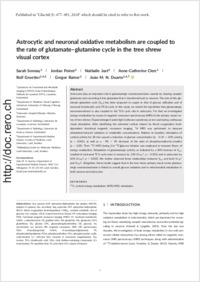Astrocytic and neuronal oxidative metabolism are coupled to the rate of glutamate–glutamine cycle in the tree shrew visual cortex
- Sonnay, Sarah Laboratory for Functional and Metabolic Imaging (LIFMET), Ecole Polytechnique Fédérale de Lausanne (EPFL), Lausanne, Switzerland
- Poirot, Jordan Department of Medicine, Visual Cognition Laboratory, University of Fribourg, Switzerland
- Just, Nathalie University Hospital Münster, Münster, Germany
- Clerc, Anne-Catherine Laboratory for Functional and Metabolic Imaging (LIFMET), Ecole Polytechnique Fédérale de Lausanne (EPFL), Lausanne, Switzerland
- Gruetter, Rolf Laboratory for Functional and Metabolic Imaging (LIFMET), Ecole Polytechnique Fédérale de Lausanne (EPFL), Lausanne, Switzerland - Department of Radiology, University de Lausanne, Switzerland - Department of Radiology, University de Geneva, Switzerland
- Rainer, Gregor Department of Medicine, Visual Cognition Laboratory, University of Fribourg, Switzerland
- Duarte, João M. N. Laboratory for Functional and Metabolic Imaging (LIFMET), Ecole Polytechnique Fédérale de Lausanne (EPFL), Lausanne, Switzerland - Department of Experimental Medical Science, Faculty of Medicine, Lund University, Sweden - Wallenberg Centre for Molecular Medicine, Lund University, Sweden
-
01.03.2018
Published in:
- Glia. - 2018, vol. 66, no. 3, p. 477–491
English
Astrocytes play an important role in glutamatergic neurotransmission, namely by clearing synaptic glutamate and converting it into glutamine that is transferred back to neurons. The rate of this glutamate–glutamine cycle (VNT) has been proposed to couple to that of glucose utilization and of neuronal tricarboxylic acid (TCA) cycle. In this study, we tested the hypothesis that glutamatergic neurotransmission is also coupled to the TCA cycle rate in astrocytes. For that we investigated energy metabolism by means of magnetic resonance spectroscopy (MRS) in the primary visual cortex of tree shrews (Tupaia belangeri) under light isoflurane anesthesia at rest and during continuous visual stimulation. After identifying the activated cortical volume by blood oxygenation level-dependent functional magnetic resonance imaging, 1H MRS was performed to measure stimulation-induced variations in metabolite concentrations. Relative to baseline, stimulation of cortical activity for 20 min caused a reduction of glucose concentration by −0.34 ± 0.09 µmol/g (p < 0.001), as well as a −9% ± 1% decrease of the ratio of phosphocreatine-to-creatine (p < 0.05). Then 13C MRS during [1,6-13C]glucose infusion was employed to measure fluxes of energy metabolism. Stimulation of glutamatergic activity, as indicated by a 20% increase of VNT, resulted in increased TCA cycle rates in neurons by 12% (VTCAn, p < 0.001) and in astrocytes by 24% (VTCAg, p = 0.007). We further observed linear relationships between VNT and both VTCAn and VTCAg. Altogether, these results suggest that in the tree shrew primary visual cortex glutamatergic neurotransmission is linked to overall glucose oxidation and to mitochondrial metabolism in both neurons and astrocytes.
- Faculty
- Faculté des sciences et de médecine
- Department
- Département de Médecine
- Language
-
- English
- Classification
- Biological sciences
- License
-
License undefined
- Identifiers
-
- RERO DOC 306882
- DOI 10.1002/glia.23259
- Persistent URL
- https://folia.unifr.ch/unifr/documents/306390
Statistics
Document views: 90
File downloads:
- pdf: 218
